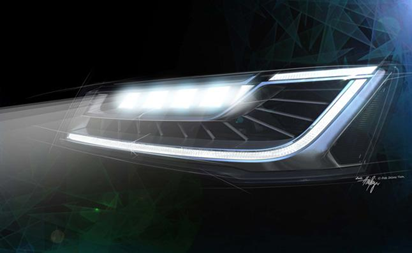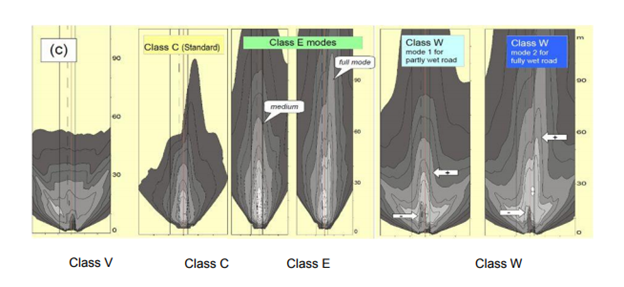Adaptive Front Lightning System
Nowadays, cars have many technologies, and we need a better safety for our car to safe our lives in night driving, Car accident statistics are jarring at night. Despite 60 percent less traffic on the roads, more than 40 percent of all fatal car accidents occur at night. About 90% driver’s reaction time depends on vision, which is impaired in dark. There are many technologies to save our life when we are driving at night, and the best technology for we driving at night is light, but there are many types of lights that can help us to save our life and can improve better sight, and the most useful is the adaptive front lightning system technology.
The adaptive front lightning system as shown in Figure 1 is one part of the safety system on car. Adaptive headlight system can be found in many general cars in this era. providing an optimized vision to the driver during night time and other poor sight conditions of the road by adapting the headlight angle and intensity, and judging the speed of the car, the weather conditions, the AFS controls the aiming directions and lightning distribution of the low beams according to the amount of turn applied to the steering wheel during cornering and turning.

Figure 1. Adaptive front lightning system [1].
An adaptive front-lighting system is defined as in ECE324-R123 as “a lighting device, providing beams with differing characteristics for automatic adaptation to varying conditions of use of the dipped-beam (passing beam) and, if it applies, the main-beam (driving-beam) with a minimum functional content , such systems consist of the "system control", one or more "supply and operating device", if any and the "installation units" of the right and of the left side of the vehicle”.
Adaptive headlight systems are made up of several subcomponents that are monitored and controlled by an electronic control unit (ECU). The subcomponents include:
- Wheel speed sensor = that monitor the speed of rotation of each wheel.
- A yaw sensor = that tracks a vehicle’s side to side movement, when turning a corner.
- A steering input sensor = that monitors the angle of the steering wheel.
- Small motors = attached to each headlight.
- A camera or laser = to monitor the road head.
The data from the sensors are interpreted by the ECU, which then determines the vehicle’s speed, and the angle and the length of the curve it is negotiating. The ECU directs the motors attached to each headlight to move the beam to the degree specified by the ECU. The newer version of the advanced headlight system has even larger ranges of motion.
The AFS works with the automatic headlights adjusting system to sense changes and loading conditions of the passengers and luggage, and adjust the vertical aim of the low beam headlights automatically to compensate for load.
Figure 2 shown AFS have many major functions, such as:
- Town passing beam (Class V)
- Basic/Country passing beam (Class C)
- Motorway passing beam (Class E)
- Wet-road passing beam (Class W)
- Static cornering light
- Dynamic swivel/level lighting

Figure 2. Adaptive Front Lightning System Function [2].
1. Town passing beam (Class V)
At speed below 50 km/h , town light provides a wider light distribution at reduce range , helping driver to more clearly see pedestrian on the edge of the road .
2. Basic/Country passing beam (Class C)
The basic lights illuminates the left and right hand edges of the road more brightly and widely then the convetional low beam . it is usually actived at speeds between 50 and 100 km/h .
3. Motorway passing beam (Class E)
Motorway light improves vision on highways and expressways. From 100 km/h, this beams illuminates the roadway significantly further ahead and focuses
4. Wet-Road Passing beam (Class W)
This beams activated when the rain sensor detects precipitation or the windshield wipers are on for 2 minutes or more. The edges of the road are more strongly illuminated for better orientation to the guiding lines.
5. Static cornering light
Static cornering light helps during maneuvers in dark access roads. At speed up to 40 km/h , one additional cornering light comes on when the indicator is actuated or the steering wheel turned through about 90 degrees to the right or the left .
6. Dynamic swiveling and leveling
- Leveling: The AFS adjusts the direction of the headlight (projector) vertically according to the front and rear chassis height sensors. adjusting the pitch angle of the headlight according to static vehicle load transfer ( occupant numbers, luggage) is called static leveling , while adjusting headlight pitch angle according to dynamic vehicle load transfer (acceleration, deceleration) is known as dynamic leveling.
- Swiveling: The AFS swivels the headlights horizontally by judging the input from the steering angle sensor and the speed of the car. The system provides a curve rate at up to 15 degrees, obstacle become more easily visible.
So Adaptive Front Lightning (AFS) System really help us to driving at night, especially when the road winding and dark. There are many types of technology that can help us at night but the Adaptive Front Lightning System (AFS) is the best technology to help us driving at night in this era.
contributor : Laurentius Reynaldy (ARE Semester 1 2017/2018)
References :
2. http://www.ti.com/lit/ug/spruhp3/spruhp3.pdf
3. https://www.edgarsnyder.com/car-accident/cause-of-accident/driving-at-night.html
4. http://www.autoguide.com/blog/wp-content/uploads/2013/06/audi-a8-matrix-led-headlights.jpg

Comments :